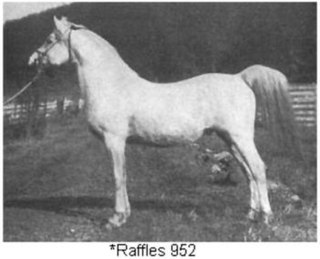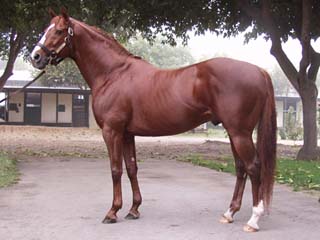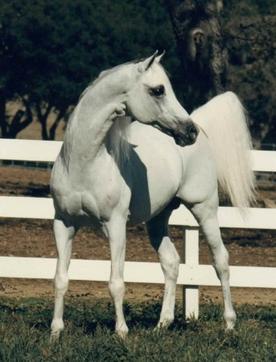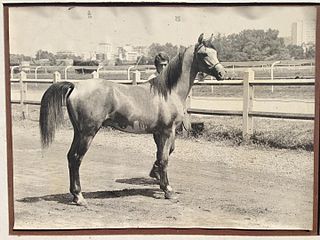Soviet-era Arabian horse program
Arabians were re-introduced to the new Tersk Stud in 1925 [9] and the first French Arabian imports arrived in 1930. These included the stallion Kann and six mares, most notable of which was Carabine. [10] Koheilan IV was imported from Hungary. The French horses had generally good conformation but were lacking Arabian type, so the stud’s managers searched for quality breeding stock with the characteristic Arabian refinement. In 1936, a shipment of 25 horses came from Crabbet Arabian Stud in England, [5] some of which were descended from horses that had lived at the Stroganov and Shcherbatov stud and perished during the revolution. There were six stallions in the purchase, of which Naseem (a son of Skowronek and great-grandson of Mesaoud) was the most influential. Among the mares, Rissalma, Rixalina, and Star of the Hills left a significant impression on the breed. [11] Tersk attempted to purchase Skowronek himself from Crabbet Stud, but he was not for sale.
World War II added significant bloodstock to Tersk, at the expense of Poland’s Arabian breeding program. In 1939 the Soviets removed many of the best Arabians bred at Janów Podlaski Stud Farm in Poland and marched them over 1,000 miles back to Tersk Stud. [12] Among the horses making the trek was Mammona, a bay suckling filly whose name meant “treasure” in Polish. Mammona’s sire, Ofir, was also in the group of horses moved to Tersk. He had already left his mark on the breed by siring the famous "three Ws" in Poland: Witraz (the sire of *Bask), *Witez II, and Wielki Szlem. [13] Ofir did not sire the same caliber of horses at Tersk as he did in Poland. [14]
In 1941, to evade the advancing German troops, the Tersk horses were evacuated to western Kazakhstan where they faced harsh weather and terrain. However, they returned to Tersk in 1943 with few losses. [15] [16]

The Ofir daughter, Mammona, had an extensive influence upon the Tersk breeding program. She produced the stallion Pomeranets, who influenced both the Arabian and Trakehner breeds; the mares Nomenklatura (dam of Nabeg), Monopolia (dam of Monogramma), Metropolia (dam of *Menes), Malpia (dam of *Muscat, 1980 U.S. & Canadian National Champion Stallion, and *Moment), and *Magnolia (dam of *Marsianin, 1981 U.S. National Champion Stallion). [13]
Aside from Ofir, other notable stallions brought to Tersk from Poland included Piolun, the sire of Priboj (out of Rissalma, who had been purchased from Crabbet Arabian Stud); and Taki Pan, the sire of the mare Taktika, who produced the mare Ptashka and the stallions *Pietuszok and Topol (all by Priboj). Topol's son Naftalin sired very good racehorses, including Aspect, who won 28 of 39 races. [17] [18] *Pietuszok was exported to Poland in 1958, [19] where he sired successful racehorses like Wosk, *Orzel, and Wilma (the dam of *Wiking, whose offspring have earned over $8 million in purses). [20]
Another of the confiscated Polish mares, Taraszcza, was bred to the Crabbet-bred stallion Naseem at Tersk and foaled a grey colt named Negativ in 1945. Negativ sired 12 foal crops in Russia, but because they did not excel on the racetrack he was sold to Poland in 1962, renamed “Negatiw,” and sired better racehorses out of the Polish mares. [21]
Negativ’s best-siring sons at Tersk were Suvenir and *Salon, [22] the latter the sire of both the U.S. and Canadian National Champion Stallion *Muscat and Tersk head sire *Moment. Another Negativ son, Nabor (later renamed *Naborr when he was imported to the U.S.), sired just 9 registered foals at Tersk, [23] apparently because his offspring were considered too delicate for the Tersk program, [24] and was exported to Poland in 1955. The Poles sought a stallion of the Ibrahim sire line, and had hoped to purchase Negativ from Tersk but were unable at the time, but were satisfied to own his son Nabor instead. Nabor was exported to the U.S. in 1963, becoming the first Tersk-bred Arabian to go to the States. *Naborr was owned in the United States by Anne McCormack, and then upon her death was purchased at auction by Tom Chauncey and entertainer Wayne Newton. [25]
None of Negativ’s Tersk-bred daughters had a significant influence on the Tersk program. [23]
After World War II, Tersk imported a few stallions from Poland: Arax in 1958, Semen in 1962, and Elfur (a full brother to *El Paso) in 1972. Of these stallions, Arax had the greatest impact on Tersk’s program, siring the influential stallion Nabeg and a number of quality daughters. [13]
Nabeg's most influential daughters include the U.S. National Top Ten Mare *Poznan, and Pesnianka, a dam of race and show champions in Europe.
Nabeg’s sons include the stallions *Menes, *Pesniar, and *Nariadni, all three imported to the U.S. Peleng, another son, was sold for $3.2 million [26] [27] [28] but tested positive for piroplasmosis (Equine babesiosis) and was never permitted to enter the U.S. Nabeg can also be found in Trakehner pedigrees through some of his sons and daughters. [29] Unfortunately Nabeg died young, having left only eight foal crops.
In 1958, the Sid Abouhom son Nil (named Azmy in Egypt [30] ) was a gift to the Soviet Union from Egypt in appreciation for the USSR’s assistance in funding the Aswan Dam. Nil sired only 16 foals [23] before his untimely death in 1960, [31] but still left a lasting impression on the Tersk program. His loss was unfortunate because, based on his structure and brief siring record, Nil could have been as significant to Tersk as his successor. In 1963, the Egyptian government gave another stallion to the Soviet Union, Raafat by Nazeer, who was renamed Aswan by the Soviets in honor of the dam project.

Aswan had a profound influence on the Tersk breeding program. As a whole, the broodmare band at Tersk had generally good structure but lacked some elements of Arabian type. Aswan introduced a more extreme dished head with large nostrils, large expressive eye, long level croup, and high tail carriage. He also had obvious faults, such as offset front knees, post-legged back legs, a long low back, a "wasp-waist," and a thick neck and throatlatch. But because Aswan’s faults were different than the Tersk mares’ faults, they often complemented each other well. [32]
Aswan sired 299 offspring over 20 seasons at Tersk, [23] more than any other stallion in the stud’s history. [23] [33] Some of Aswan’s best-known sons included Palas (out of a daughter of Nil, the first stallion given to the USSR by Egypt), who was exported to Poland and became a head sire at Janów Podlaski Stud Farm for many years; Kilimanjaro, a German National Reserve Champion who sired champions in North America and Europe; Patron, who sired the U.S. and Canadian National Champion Stallion *Padron before his untimely death; and Plakat, a European champion who sired many champions himself.
Aswan excelled at siring broodmares. Examples include Pesnia, the dam of *Pesniar, who was purchased for $1 million and imported to the U.S. in 1981; [34] Molva, called Aswan’s most beautiful and best-producing daughter by former Tersk director Alexander Ponomarev [35] and the dam of Wympel; and Karinka, a full sister to Kilimanjaro, an accomplished race mare and the dam of Russian Derby winner and European Champion Stallion Drug. [36]
The *Menes son Balaton, out of the Aswan daughter Panagia, was foaled in 1982 at Tersk and was immediately identified as the stud’s next great hope. Balaton became one of the youngest stallions to become a head sire at Tersk at just three years of age, and Tersk Director Alexander Ponomarev called him "the horse of the century at Tersk" [37] after his first foal crop arrived.
The Balaton son Kubinec, out of the *Muscat daughter Kosmetika, was foaled at Tersk in 1987. A chestnut with a wide blaze going all the way over his nose and lips, Kubinec’s white markings weren't considered acceptable in the Tersk breeding program. According to Dr. O.A. Balakshin of the All Russian Research Institute of Horse Breeding, “Too many horses now have white markings on their head and legs. This is undesirable and should be eliminated by selection.”. [22] Kubinec was sold in 1991 and began making his mark in European show rings. He was named German National, European, and World Champion Stallion as well as European Conference of Arab Horse Organizations (ECAHO) "Five Star Stallion" [38] and his offspring are desirable around the world today.
In the mid-1980s, Tersk Stud introduced a few different outcross stallions, such as the Polish imports Gvizd ("Gwizd" in Poland) and Harfiaj ("Harfiarz" in Poland) and the English-bred pure Spanish Esplendor. [37] Gvizd, Harfiaj, and Esplendor left Tersk but some of their descendants were used in the Tersk breeding program. [23] Of the three outcross stallions, Gvizd had the greatest influence through a few of his daughters and his son, Negasimyi, who later became a sire of racehorses at Tersk in the mid-1990s. Gvizd's daughter Purga produced the stallion Padishah (by race winner Drug), who won several halter championships in Europe in the early 2000s. [39] Gvizd also sired Pogojii, winner of four stakes races in Russia. [40]















